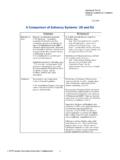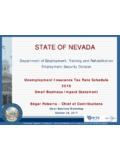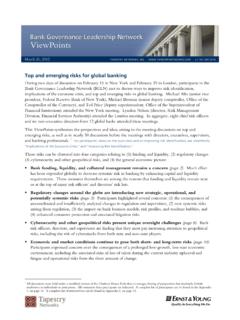Transcription of The next stage - EY - United States
1 The next stageSolvency II, the QIS5 results and implications for the USSolvency II and the results of QIS5 should not be viewed as a regulatory framework affecting only European next stage solvency II, the EIOPA QIS5 report and the US implicationsThe global solvency environment is about to undergo major changes, moving toward a more principles-based approach with incentives for sound risk management. In Europe, solvency II will be the new reference regulatory framework from 2013 onward, and there is a growing recognition that data and technology are on the critical path for solvency II development and that the greater the risk management ambition, the greater the challenge.
2 Despite the initial difficulties in adapting to this new regime, complying with solvency II also provides incentives for sound risk management practices and enhanced transparency. In conjunction with the proposed changes to global solvency standards by the International Association of Insurance Supervisors (IAIS), the effects of solvency II will be felt worldwide as external disclosure of economic capital and risk-adjusted performance become more common and stakeholders around the globe, particularly those in the US, will be requiring enhanced financial risk disclosure. In this context, US companies should start benchmarking their current risk management framework with leading European practices and enhance their communications to stakeholders to offer more financial risk disclosure.
3 solvency II could also impact the geographic flow of capital and create opportunities for US insurers by assisting European companies in the improvement of their solvency capital requirement (SCR) through reinsurance solutions to mitigate certain risks. Therefore, solvency II could have implications with regard to the competitiveness of domestic US (re) insurance companies, and it should not be viewed as a regulatory framework affecting only European fact, stakeholders would want to assess their capital and risk management and compare it to that of insurance companies across the globe. solvency II public disclosure will include business overview and performance, the bases and methods used for the valuation of assets and liability together with an explanation of any major differences with other financial statements.
4 In addition, a description of the system of governance and an assessment of its adequacy for the risk profile of the insurer should be provided. Risk disclosure will include a description of the risk exposure, risk mitigation and sensitivity, as well as a detailed description of the capital completion of the fifth Quantitative Impact Study (QIS5) by the European Insurance and Occupational Pensions Authority (EIOPA) on 14 March 2011, marks a major milestone in the full implementation of solvency II. It is not only the end of the impact study that ran its course during 2010, but it is probably the final full-scale test of its type to be conducted prior to the establishment of solvency II.
5 The purpose of QIS5 was to test the practicability, implications and impact of solvency II on the financial aspect of (re) insurers subject to solvency II. Outlined in the following pages are the major highlights and key points noted by the 70% of the European insurance industry participated in the study, making it the most comprehensive test of solvency II proposals to date. The results (which apply to insurance balance sheets at the end of 2009) indicate a reduction of surplus of 56 billion compared to the current solvency I regime. The study shows that 15% of European participants could not cover their SCR and would prompt regulator action.
6 Five percent of the participants could not cover their minimum capital requirement (MCR) and would trigger major regulatory intervention. In addition, there are many areas about which firms have expressed their own concerns, ranging from the type of method to the calibration or the simple practicality of performing the calculations. Given this uncertainty, Ernst & Young supports the concept of transitional measures that will help smooth the impact and give firms and regulators time to achieve an orderly transition to the new regime. The following pages summarize some of the key highlights from the QIS5 report, with further selected comments and supporting graphs.
7 Note that this is not intended to be a comprehensive summary, but rather an abbreviated snapshot of the full report. Please refer to the full EIOPA report for a complete presentation of QIS5 II is a regulatory project that will provide a risk-based, economic-based and principles-based framework for the supervision of European (re)insurers: solvency II removes any implicit prudence embedded in the technical provisions currently existing in the solvency I regime. The valuation of technical provisions is based on the calculation of a best estimate and a risk margin. The capital requirements will be determined on the basis of the risk profile of the (re)insurance companies, as well as on the way in which such risks are managed, as compared to the simplistic factor approach taken for the determination of the required solvency margin in solvency I.
8 The SCR corresponds to the Value-at-Risk of the basic own funds of an insurance or reinsurance company, subject to a confidence level of over a one-year period. The calculation of the SCR according to the standard formula is divided into risk modules (market, health, default, life underwriting, non-life underwriting and intangibles, etc.). For each module and sub-module (interest rate, illiquidity, mortality, lapse etc.), a list of specifications and simplifications is defined in the QIS5 report. solvency II provides incentives for sound risk management. Companies have the option to use partial and full internal models (subject to supervisory approval) to calculate the capital requirement, instead of applying the standard formula.
9 Basic own funds and ancillary own funds represent available financial resources in excess of liabilities, which are able to back required capital (SCR and MCR), will be classified into three tiers depending on their permanent availability and their Overall financial impact. There was a decrease in the level of surplus (in excess of capital) overall. This is the combined impact of an average increase in the level of own funds compared to solvency I; a decrease in technical provisions; and, depending on the current local accounting regime, an increase in value of assets, as well as an overall increase in capital requirements.
10 Valuation of assets. There was a wide variety in the treatment of deferred taxes and affiliates, as well as difficulty in determining the valuation of intangibles. Technical provisions. An overall decrease of in net technical provisions was observed for all lines of business. Key issues include broad use of simplifications in the risk-margin calculation; lack of clarity in the definition of contract boundaries; inconsistent application of the illiquidity premium buckets; and limited value from detailed segmentation by line of business for life companies. SCR and MCR. Main risk drivers are market risks (equity, spread and interest rates), followed by non-life underwriting risks.














